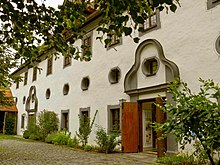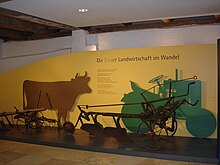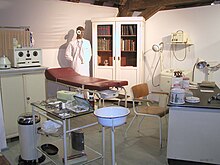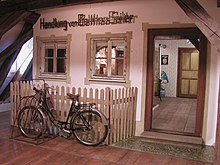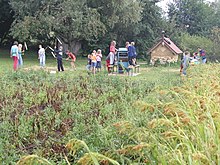Museum KulturLand Ries
The cultivated land Ries Museum (formerly. Rieser Bauernmuseum Maihingen ) is the region of Swabia worn Museum in Maihingen . Located in a baroque monastery, it focuses on the everyday life of the rural population in Nördlinger Ries . A museum educational program and numerous special events complete the offer.
Location
15 km north of Nördlingen , near the Romantic Road , lies the former Birgittenkloster Maihingen , which was founded in 1472, on the edge of the Ries crater . From 1607 until its abolition in 1803 it was run by the Franciscan Minorites . The baroque complex with its splendidly furnished monastery church is embedded in a charming landscape. The KulturLand Ries museum is located in two of the ensemble's former buildings.
The elongated former monastery economy now houses the extensive permanent exhibition “Giant Agriculture in Transition”, the administration wing as well as the workshop and a depot. In the former brewery, which was in operation until 1935 after secularization , there is the permanent exhibition "300 years of everyday culture in the Ries" as well as a room for special exhibitions and a room for museum education. The total exhibition area amounts to approx. 2,400 m².
The Maihingen village and field path of the Rieser Bauernmuseums- und Mühlenverein begins at the museum and leads around the Klosterberg and the village. The association has been running a mill museum in the barn of the former monastery mill since 1997.
timeline
- 1973: Foundation of the Rieser Bauernmuseum association
- 1978: The Rieser Bauernmuseum association buys the agricultural part of the former monastery economy and secures the former monastery brewery, which it begins to renovate.
- 1984: Opening of the brewery as a museum
- 1985: The district of Swabia takes over the sponsorship of the museum with the participation of the district of Donau-Ries.
- 1987: District administrator Hans Frei takes over the museum management and thus the management of the museums in Maihingen and Oberschönenfeld, which are supported by the district .
- 1989: Acquisition of the monastery economy by the district and start of renovation
- 1994: Opening of the monastery economy with special exhibitions
- 1998: Opening of the agricultural exhibition in the monastery economy
- 2001: The Rieser Bauernmuseum association opens the village and field nature trail. The renovation and redesign of the brewery begins.
- 2004: After Hans Frei retired in 2002, the museum management was dissolved in 2004 and the two museums were now run independently. In Maihingen, Ruth Kilian - employed as a scientist since 1987 - is officially appointed head.
- 2015: Opening of the new permanent exhibition "300 years of everyday culture in the Ries" in the former brewery
- 2015: Renaming to Museum KulturLand Ries
Exhibitions
Permanent exhibitions
"Giant Agriculture in Transition"
The exhibition Rieser Landwirtschaft im Wandel spans an arc from 1800 to 1950 under the motto “From the cow team to the tractor, from the sickle to the mower, from the subject to the entrepreneur, from the collective work to the one-man business” Manual work for full mechanization.
After the abolition of the manorial power in the middle of the 19th century, the farmer owned his land himself and was able to invest in the modernization of his farm without fear of higher taxes. Agricultural schools, agricultural associations, literature and exhibitions imparted the new professional and technical knowledge to the farmers. The fallow land of the three-field farming was used for the cultivation of potatoes or new forage crops such as clover , and the overall yield was increased through targeted fertilization . Iron devices gradually replaced the wooden ones, the railroad made it easier to transport goods and machines saved manpower. Savings and loan associations granted loans for the expensive investments in mechanization; Machines, seeds and fertilizers were also obtained through cooperative associations .
Using the example of the Ries as an important agricultural landscape in Swabia and Bavaria , developments in Bavaria as a whole are shown, the interweaving of technological, social and economic history. Historical photos, films and productions tie the objects into their earlier context of use and models invite you to try them out.
"300 years of everyday culture in the Ries"
Since June 2015, a new permanent exhibition on four floors has been offering insights into everyday life in the Ries in the former brewery.
The barrier-free tour begins with an orientation about the region and its special features, such as the formation caused by an asteroid impact. Another special feature of the giant is his costume, which was also an expression of the respective denomination, until finally ready-made goods filled the cupboards.
A grocer and a dairy shop from the 1920s with their original furnishings form the starting point for dealing with advertising and goods packaging. Medical care was provided by u. a. Midwives, baths and pharmacists. Separate rooms have been set up for the doctor and dentist. A women's and a men's salon from the 1950s have been staged as the successor to the Bader.
A colorful palette of painted furniture from Rieser Werkstätten refers to the earlier home decor. A “chancellery”, a separate area in some farm rooms, has also been set up. With industrialization, countless “little helpers” appeared on the market that were supposed to make work easier for housewives. Finally, the focus is on childhood, with a variety of toys, but also the work performed by children.
Interactive media stations hold, for example, filmed interviews, listening stations with dialect or other images. You can hear their stories for five dresses. And with the radios and turntables, the visitor can make a selection from sound documents of the respective time. A girl explains in a film how one can count on the museum abacus. An “airy walk” over the Ries concludes the foray into the everyday history of the region.
The Ries was famous for its geese - a goose leads the children on a journey of discovery through the exhibition.
Special exhibitions
In more than 50 special exhibitions to date, the museum has explored a range of topics ranging from superstition to dentists and including objects from the advent calendar to the bridle. Art exhibitions have sometimes looked at the Ries, its villages and people from an unfamiliar perspective and Christmas exhibitions presented historical Christmas tree decorations, paper antiques, dollhouses, toys or nativity scenes in an atmospheric ambience.
Selection of previous special exhibitions
- “Witch stitch and boat tip. Old handicrafts in the Ries "(1987)
- “Arbira, Arbira… the potato. History, devices, products "(1988)
- “Pictures in the farmhouse. Popular wall decorations around 1900 "(1989)
- "Doll houses, dollhouses, doll kitchens" (1992)
- “Elegantly decorated. Rural clothing in the Ries "(1994)
- “I will come to the Lord's table. Confirmation and communion in the Ries "(1996)
- "Poultry. Geese in the Ries "(1997)
- “When Aunt Emma was still serving. Grocer and milk shop in Ries "(1999)
- "Between superstition and popular piety" (2001)
- “Bathers, midwives and doctors. About medicine in the Ries "(2002)
- "Christmas on Paper" (2002/03)
- “Rocking horse and doll's pram. Children's wishes for Christmas "(2003/04)
- “Seductively packaged. Advertising and the colorful world of goods "(2005)
- “Cow trade. On dealing with a farm animal "(2006)
- “Lovely and functional. On the cultural history of underwear "(2007)
- “'It's easier that way!' Technology in the household "(2008)
- “The sweet seduction. Sugar, Chocolate & Co. "(2009)
- "Rosary and Luther Bible - The Denominations in the Ries" (2012)
- "Stylus, fountain pen, ink killer - elementary schools in rural Bavaria 1945–1970" (2013)
- "Triggers Ries! Photographs from the Förstner estate" (2017)
- "PuppenStubenWelten" (2017/18)
- "Bread. Food with Culture" (2018)
- "Utopia Agriculture" (2019)
Special events
During the museum season, numerous events are on the program: from readings by regional poets to folk music afternoons to hands- on days for the whole family.
GenussKulturMarkt
Regional producers and marketers present a variety of culinary delights and provide a lot of information.
Potato feast
At the potato festival, the “arbira” are the center of attention. Harvesting and field cultivation are demonstrated with historical equipment. Visitors can harvest potatoes themselves , marvel at historical potato varieties, children make things from the "great tuber" and competitions are held to find the largest potato and the fastest peeler.
Reaper Festival
At the Schnitterfest (celebrated earlier at the end of the harvest), visitors can experience how the grain harvest used to take place. In several demonstrations initially come Gaukel , sickle and flail , and later binding mower and wide thresher used. Old tugs are used to plow. A show of vintage tractors complements the festival.
Museum educational program
Museum education aims to introduce both large and, above all, small visitors to historical and cultural topics in a vivid and in-depth manner. Guided tours of a general nature or to special aspects are just one of many possibilities. The KulturLand Ries museum (formerly Rieser Bauernmuseum) has a wide range of offers aimed specifically at groups of children and school classes: from baking bread to “school 100 years ago” to buttering and apple musts, you can try everything yourself. A holiday program is also available during the summer holidays. The museum also has ideas for children's birthdays.
Publications
- Bruno Langner: Seductively packaged. Colorful world of goods and advertising. Maihingen 2005
- Ruth Kilian: The Rieser agriculture in transition. Augsburg 2002
- Ruth Kilian: Look at the Ries. Nordlingen 2000
- Anja Lippert: Poultry . Geese in the Ries, Nördlingen 1997
- Ruth Kilian: Rieser villages and country life 100 years ago. Drawings by the Geiß family from Ebermergen . Nordlingen 1996
- Friedhelm Brusniak (among others): Ways of folk music. Example Ries. Gessertshausen 1992
- Ruth Kilian, Eva Gilch: Markets and fairs in the Ries. Gessertshausen 1990
- Ruth Kilian: The potato. History, devices, products. Gessertshausen 1988
See also
Web links
Coordinates: 48 ° 55 ′ 44 ″ N , 10 ° 29 ′ 29 ″ E
